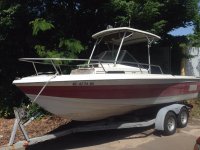First and foremost check the transom. First test is the "rap" test. Use a wooden or plastic mallet and bang all over the transom. There should be a solid, even rap everywhere. If some areas give off a duller "thud", that is a potential problem. If any "thud" areas, drill through the gelcoat and fiberglass into the wood. Use an ice pick to see if wood is soft. If so, that needs to be repaired. Typically, you will get rot down around the bilge drain and around any holes in the transom for things like motor mounts, trim taps, etc. If more than just one or two isolated areas, then the transom should be totally rebuilt. Not cheap!
Next, inspect the keel very closely for any breaks in the gelcoat and underlying fiberglass. Do the rap test on the keel also. Small breaks in the keel fiberglass can be repaired externally with a good marine epoxy and an overcoat of gelcoat as long as the keel itself is still solid. If the keel is compromised, junk the boat.
Next check the deck first by walking around on it to see if there are any spongy areas or areas where it sags. You can do the rap test there also. If deck is compromised, then it should be removed so you can inspect the ribs, stringers, etc. and the other side of the keel. On that type of boat I don't think the deck would be that hard to rebuild using marine ply and liberal amounts of fiberglass.
Finally, completely dry out the bilge and launch the boat in the water and let it sit there for a day or so, then check the bilge for any water. If there is water, you need to find out where it is coming from. In the past, I have blocked up the boat on it's trailer and filled the bilge with water to find out where it is leaking. 90% of the time it will be either around the bilge drain hole or an underwater fitting for a wash down pump or for a bait tank.
If all that checks out and does not require any significant repairs, then you are back to figuring out how you want to re-power the boat. As I said before, I'm partial to outboards with an engine extension IF YOUR BOAT CAN HANDLE THE EXTRA TRANSOM WEIGHT.
 Received this boat for free, will need new engine and gel coat repair throughout. Trying to decide to repair current engine or do i/o conversion to bracketed outboard. Any advice or expertise would be very appreciated. The boat was stored in water and has barnacles on bottom. Anyway I'll be posting pics as we go.
Received this boat for free, will need new engine and gel coat repair throughout. Trying to decide to repair current engine or do i/o conversion to bracketed outboard. Any advice or expertise would be very appreciated. The boat was stored in water and has barnacles on bottom. Anyway I'll be posting pics as we go.
